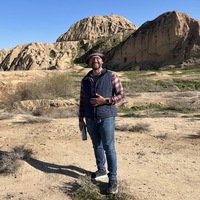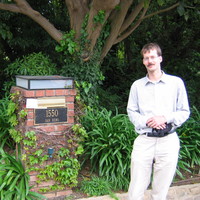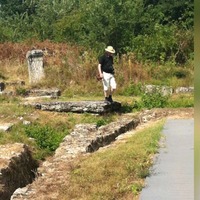Papers by Olga Inevatkina
Материальная культура Востока. Государственный музей Востока . Москва, 1999
В статье представлены первые фрагменты сюжетной живописи времен Караханидов, случайно найденны... more В статье представлены первые фрагменты сюжетной живописи времен Караханидов, случайно найденные в 1985 году на цитадели домонгольского Самарканда. (The article presents the first fragments of narrative painting from the Karakhanid period, accidentally found in 1985 on the citadel of pre-Mongolian Samarkand).
한국콘텐츠학회논문지 = The Journal of the Korea Contents Association, Mar 1, 2010
La construction de Samarcande sur la rive gauche du Zerafchan sous Darius I er dans la seconde mo... more La construction de Samarcande sur la rive gauche du Zerafchan sous Darius I er dans la seconde moitie du VI e s. av. J.-C. se fait conjointement avec l'appropriation autour de la capitale de nouvelles zones agricoles basees sur le canal Dargom, entrainant ainsi une nouvelle repartition de l'equilibre economique dans la Sogdiane pre-achemenide.
Les Dossiers D Archeologie, 2010
История и археология Турана. №3. 426 с. Ответственный редактор А.Э. Бердимурадов . Самарканад, 2017

Scripta antiqua. Вопросы древней истории, филологии, искусства и материальной культуры: альманах / [гл. ред. М. Д. Бухарин] ; Междунар. ин-т античного мира. — М. : Собрание, . Т. 5. — 2016. — 536 c. , 2016
In this article on the basis of cartographic and archaeological sources
we offer the reconstructi... more In this article on the basis of cartographic and archaeological sources
we offer the reconstruction of an ancient transport system of the Leftbank
of the Middle flow of Zeravshan, that connected the main cities of
ancient Sogd – Samarkand and Bukhara. The historical maps of the New
time fixed the existence of two branches of Bokhara road – one of them,
coastal branch led from Kattakurgan to Samarkand. Nowadays it is lost.
And the other, that is operating now – Djuma road. Archaeological data
indicates the ancient origins of the coastal branch, and since the middle of
the first millennium BC., this road was of State importance. Bukhara road
that crosses Pastdarg’om territory, as well as an ancient Kesh road, that led
to the Southern Sogd, represents the ways of the formation of the historic
landscape in this important area of Samarkand’s Sogd
The paper advances the typology of Samarqand Soghd archeological monuments on the basis
of archeo... more The paper advances the typology of Samarqand Soghd archeological monuments on the basis
of archeological study of Durmen settlement (the ancient Isbisket) and archeological survey
undertaken by Central Asian expedition of State Museum of The East Nations Art in 1986–1991
in Pastdargom District of Samarqand Province in Uzbekistan. Twenty two types of monuments
are identi ed, including dwellings, military architecture, worship buildings, burial monuments,
hydraulic facilities, arable land and excavation facilities, etc.
Key words: Central Asia, Soghd, archeology, aerophotography, monument typology,










Uploads
Papers by Olga Inevatkina
we offer the reconstruction of an ancient transport system of the Leftbank
of the Middle flow of Zeravshan, that connected the main cities of
ancient Sogd – Samarkand and Bukhara. The historical maps of the New
time fixed the existence of two branches of Bokhara road – one of them,
coastal branch led from Kattakurgan to Samarkand. Nowadays it is lost.
And the other, that is operating now – Djuma road. Archaeological data
indicates the ancient origins of the coastal branch, and since the middle of
the first millennium BC., this road was of State importance. Bukhara road
that crosses Pastdarg’om territory, as well as an ancient Kesh road, that led
to the Southern Sogd, represents the ways of the formation of the historic
landscape in this important area of Samarkand’s Sogd
of archeological study of Durmen settlement (the ancient Isbisket) and archeological survey
undertaken by Central Asian expedition of State Museum of The East Nations Art in 1986–1991
in Pastdargom District of Samarqand Province in Uzbekistan. Twenty two types of monuments
are identi ed, including dwellings, military architecture, worship buildings, burial monuments,
hydraulic facilities, arable land and excavation facilities, etc.
Key words: Central Asia, Soghd, archeology, aerophotography, monument typology,
we offer the reconstruction of an ancient transport system of the Leftbank
of the Middle flow of Zeravshan, that connected the main cities of
ancient Sogd – Samarkand and Bukhara. The historical maps of the New
time fixed the existence of two branches of Bokhara road – one of them,
coastal branch led from Kattakurgan to Samarkand. Nowadays it is lost.
And the other, that is operating now – Djuma road. Archaeological data
indicates the ancient origins of the coastal branch, and since the middle of
the first millennium BC., this road was of State importance. Bukhara road
that crosses Pastdarg’om territory, as well as an ancient Kesh road, that led
to the Southern Sogd, represents the ways of the formation of the historic
landscape in this important area of Samarkand’s Sogd
of archeological study of Durmen settlement (the ancient Isbisket) and archeological survey
undertaken by Central Asian expedition of State Museum of The East Nations Art in 1986–1991
in Pastdargom District of Samarqand Province in Uzbekistan. Twenty two types of monuments
are identi ed, including dwellings, military architecture, worship buildings, burial monuments,
hydraulic facilities, arable land and excavation facilities, etc.
Key words: Central Asia, Soghd, archeology, aerophotography, monument typology,